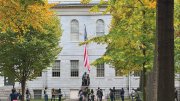In its 375th anniversary issue, a piece in Harvard Magazine's Regional section explores how Harvard Square has changed over the last quarter century—the focus of this video. Watch and listen to the owner of Cardullo's (a gourmet food shop), the Hong Kong (a Chinese restaurant and dance/comedy club), and Grendel's Den (a bar/eatery) describe the changes that have unfolded in front of their eyes since 1986.
Harvard Square history video tour
Harvard Square history video tour
This video explores 25 years of change in Harvard Square, through the eyes of small business owners.
You might also like
How AI Is Reshaping Supply Chains
Harvard Kennedy School lecturer on using AI to strengthen supply chains
This Astronomer is Sounding a Warning on ‘Space Junk’
As debris accumulates in low Earth orbit, the danger of destructive collisions continues to rise.
Understanding AI Vulnerabilities
As artificial intelligence capabilities evolve, so too will the tactics used to exploit them.
Most popular
Explore More From Current Issue

A Changed Harvard Faces the Future
After a tense summer—and with no Trump settlement in sight—the University continues to adapt.

This Harvard Scientist Is Changing the Future of Genetic Diseases
David Liu has pioneered breakthroughs in gene editing, creating new therapies that may lead to cures.





